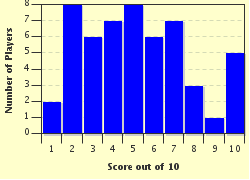Quiz Answer Key and Fun Facts
1. Starting at the beginning, which of these scientists was the first to theorize quantized energy?
2. What concept in physics came to be known as the "ultraviolet catastrophe"?
3. The term that refers to an interference pattern in which the crests one of one wave match up with the troughs of another wave is known as a constructive interference pattern.
4. Which quantum number denotes the orientation of atomic orbitals containing electrons?
5. Who solved the photoelectric effect?
6. Which one of these particles is not a fermion?
7. Which of these rays does not belong to the electromagnetic spectrum?
8. What region of the electromagnetic spectrum does the Paschen series belong to?
9. Hund's rule states that before atomic orbitals fill up, each orbital contains only one electron. All of these electrons share one of the same quantum numbers. Which one is it?
10. Which scientist was awarded the Nobel Prize in 1965 in physics for their work in quantum mechanics?
Source: Author
happy1234512
This quiz was reviewed by FunTrivia editor
WesleyCrusher before going online.
Any errors found in FunTrivia content are routinely corrected through our feedback system.

